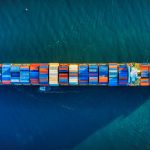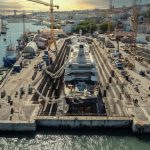Russian government officials, Rosatom, and the JSC Baltic Shipyard marked the completion of the fourth massive nuclear-powered icebreaker with a ceremony hoisting the national flag on the vessel. Rosatom highlighted that it is a key component of the strategy for the Northern Sea Route and the efforts to maintain year-round transit in the western Arctic region.
Rosatom Director General Alexey Likhachev highlighted that this is the fourth vessel and the third serial nuclear-powered icebreaker in Project 22220 while noting that the company has eight vessels in its nuclear icebreaker fleet. By 2030, he predicted the icebreaker group on the Northern Sea Route will reach 17 vessels.
He also reported that when the final calculations are done for 2024, they will set a new record for the total volume of cargo on the route. The forecast is that the volume will be close to 38 million tons on the NSR in 2024.
The construction contract for two icebreakers was signed in August 2019, with the first of the vessels named Yakutia now completed. The keel was laid in May 2020 at the Baltic Shipyard and the vessel was launched in November 2022. Sea trials commenced in the Gulf of Finland on December 1, 2024. The sistership Chukotka is under construction and in February 2023 they announced plans for two more icebreakers due in December 2028 and December 2030.
Officials highlighted that Yakutia differs from the previous three icebreakers, Arktika, Sibir, and Ural, because of a “large-scale import substitution measure.” In addition to delays due to the pandemic, they noted that the icebreaker’s equipment and components were replaced with domestic ones. Western exports of components for the vessels were stopped after the invasion of Ukraine.
The vessels are the largest nuclear-powered icebreakers in the world designed with a 40-year lifespan. The full displacement of the Yakutia is 33,540 tons with the capability to operate into ice up to 3 meters (nearly 10 feet) in thickness. The vessel is 173 meters (586 feet) in length and can reach 22 knots in open water.
During the flag-raising ceremony on December 28, a message was read from Russian President Vladimir Putin. “Successful implementation of this ambitious project is the result of creative endeavors by researchers and dedicated work by shipbuilders of the Baltic Shipyard and specialists from many other Russian companies. I would like to express my heartfelt gratitude to everyone who took part in creating this modern vessel, equipped it with state-of-the-art technology, employed advanced materials and engineering solutions. I am convinced that the Yakutia icebreaker will enhance the potential of our nuclear-powered fleet and facilitate addressing major multidimensional tasks that our country’s economy is facing today, as well as reinforcing Russia’s positions as a maritime power.”
The report highlights the vessel’s hull is made of durable, corrosion-resistant steel and is protected from ice formation and ice adhesion. The nuclear power plant of the Yakutia consists of two pressurized water nuclear reactors RITM-200, developed in Russia. The thermal capacity of each reactor is 175 MW. The vessel will be operated by FSUE Atomfloat, a Rosatom company.




